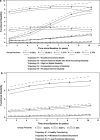Ethnicity and changing functional health in middle and late life: a person-centered approach
- PMID: 20008483
- PMCID: PMC2883869
- DOI: 10.1093/geronb/gbp114
Ethnicity and changing functional health in middle and late life: a person-centered approach
Abstract
Objectives: Following a person-centered approach, this research aims to depict distinct courses of disability and to ascertain how the probabilities of experiencing these trajectories vary across Black, Hispanic, and White middle-aged and older Americans.
Methods: Data came from the 1995-2006 Health and Retirement Study, which involved a national sample of 18,486 Americans older than 50 years of age. Group-based semiparametric mixture models (Proc Traj) were used for data analysis.
Results: Five trajectories were identified: (a) excellent functional health (61%), (b) good functional health with small increasing disability (25%), (c) accelerated increase in disability (7%), (d) high but stable disability (4%), and (e) persistent severe impairment (3%). However, when time-varying covariates (e.g., martial status and health conditions) were controlled, only 3 trajectories emerged: (a) healthy functioning (53%), moderate functional decrement (40%), and (c) large functional decrement (8%). Black and Hispanic Americans had significantly higher probabilities than White Americans in experiencing poor functional health trajectories, with Blacks at greater risks than Hispanics.
Conclusions: Parallel to the concepts of successful aging, usual aging, and pathological aging, there exist distinct courses of changing functional health over time. The mechanisms underlying changes in disability may vary between Black and Hispanic Americans.
Figures

Similar articles
-
Multiple trajectories of depressive symptoms in middle and late life: racial/ethnic variations.Psychol Aging. 2011 Dec;26(4):761-77. doi: 10.1037/a0023945. Epub 2011 Aug 29. Psychol Aging. 2011. PMID: 21875216 Free PMC article.
-
Prevalence and distribution of major depressive disorder in African Americans, Caribbean blacks, and non-Hispanic whites: results from the National Survey of American Life.Arch Gen Psychiatry. 2007 Mar;64(3):305-15. doi: 10.1001/archpsyc.64.3.305. Arch Gen Psychiatry. 2007. PMID: 17339519
-
Progressive and accelerated disability onset by race/ethnicity and education among late midlife and older adults.J Aging Health. 2012 Dec;24(8):1320-45. doi: 10.1177/0898264312459345. Epub 2012 Sep 14. J Aging Health. 2012. PMID: 22982972 Free PMC article.
-
Evolving self-rated health in middle and old age: how does it differ across Black, Hispanic, and White Americans?J Aging Health. 2010 Feb;22(1):3-26. doi: 10.1177/0898264309348877. Epub 2009 Dec 1. J Aging Health. 2010. PMID: 19952367 Free PMC article.
-
Double Disadvantage in the Process of Disablement: Race as a Moderator in the Association Between Chronic Conditions and Functional Limitations.J Gerontol B Psychol Sci Soc Sci. 2020 Jan 14;75(2):448-458. doi: 10.1093/geronb/gby027. J Gerontol B Psychol Sci Soc Sci. 2020. PMID: 29669010
Cited by
-
Discrimination, racial bias, and telomere length in African-American men.Am J Prev Med. 2014 Feb;46(2):103-11. doi: 10.1016/j.amepre.2013.10.020. Am J Prev Med. 2014. PMID: 24439343 Free PMC article.
-
Disability Trajectories at the End of Life: A "Countdown" Model.J Gerontol B Psychol Sci Soc Sci. 2015 Sep;70(5):745-52. doi: 10.1093/geronb/gbu182. Epub 2015 Mar 3. J Gerontol B Psychol Sci Soc Sci. 2015. PMID: 25740918 Free PMC article.
-
How does the trajectory of multimorbidity vary across Black, White, and Mexican Americans in middle and old age?J Gerontol B Psychol Sci Soc Sci. 2011 Nov;66(6):739-49. doi: 10.1093/geronb/gbr106. Epub 2011 Oct 3. J Gerontol B Psychol Sci Soc Sci. 2011. PMID: 21968384 Free PMC article.
-
Trajectories of Aging Among U.S. Older Adults: Mixed Evidence for a Hispanic Paradox.J Gerontol B Psychol Sci Soc Sci. 2020 Feb 14;75(3):601-612. doi: 10.1093/geronb/gby057. J Gerontol B Psychol Sci Soc Sci. 2020. PMID: 29788310 Free PMC article.
-
Nativity, Family, Disability: Results from the Hispanic Established Populations for the Epidemiologic Study of the Elderly.Ethn Dis. 2021 Apr 15;31(2):253-262. doi: 10.18865/ed.31.2.253. eCollection 2021 Spring. Ethn Dis. 2021. PMID: 33883866 Free PMC article.
References
-
- Angel RJ, Angel JL, Himes CL. Minority group status, health transitions, and community living arrangements among the elderly. Research on Aging. 1992;14:496–521.
-
- Baron RM, Kenny DA. The moderator-mediator variable distinction in social psychological research: Conceptual, strategic, and statistical considerations. Journal of Personality and Social Psychology. 1986;51:1173–1182. - PubMed
-
- Carrasquillo O, Lantigua RA, Shea S. Differences in functional status of Hispanic versus Non-Hispanic white elders: Data from the Medical Expenditure Panel Survey. Journal of Aging and Health. 2000;12:342–361. - PubMed
-
- Chen JH, Chan DC, Kiely DK, Morris JN, Mitchell SL. Terminal trajectories of functional decline in the long-term care setting. Journal of Gerontology: Medical Sciences. 2007;62:531–536. - PubMed

